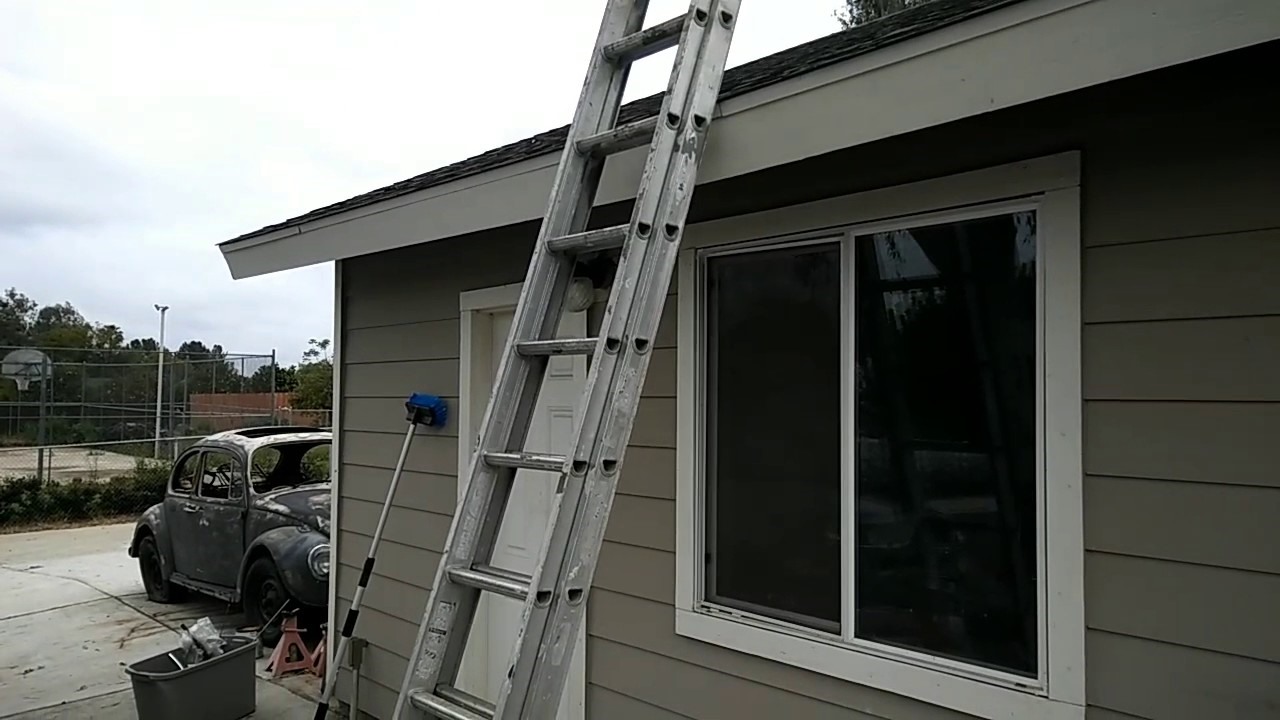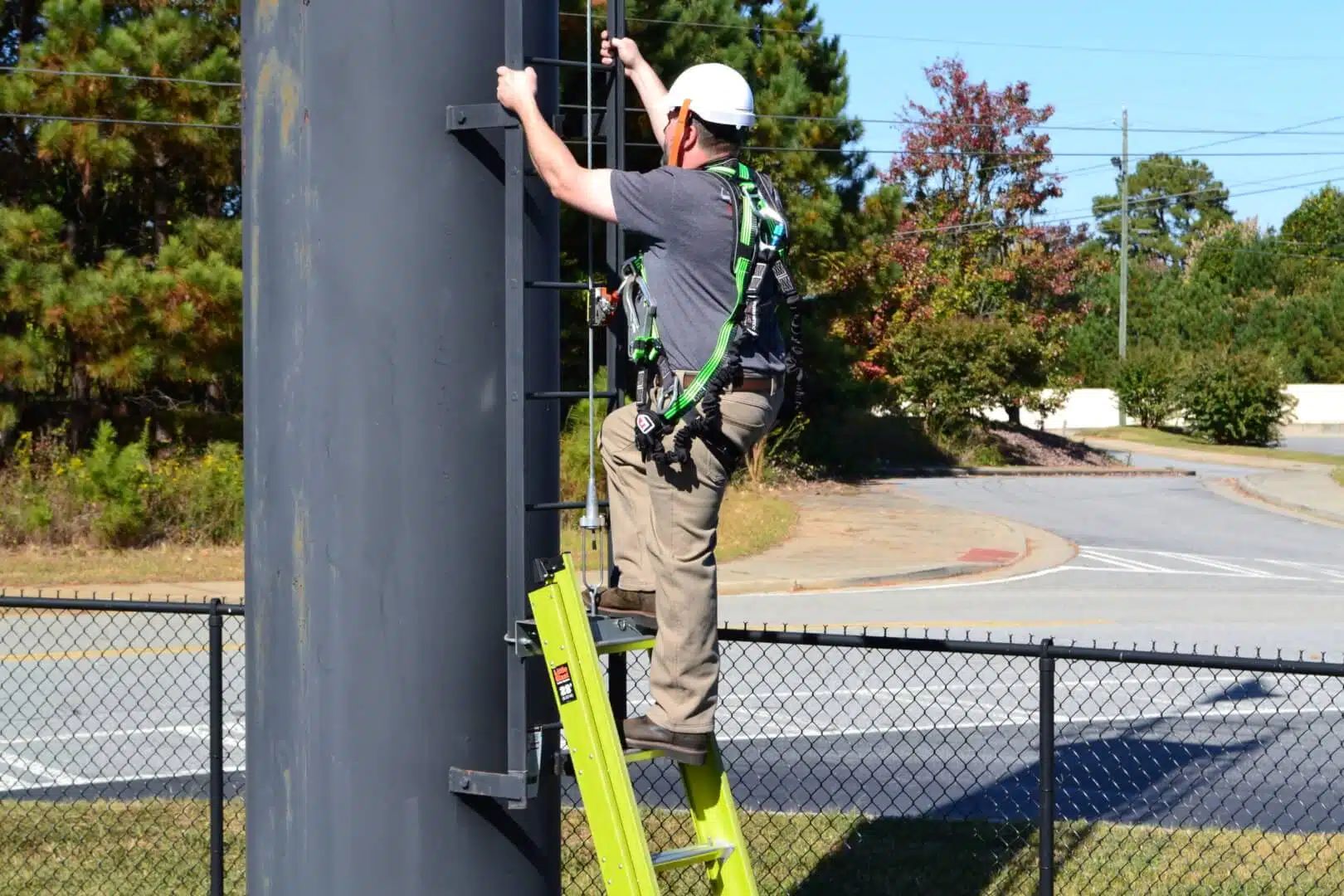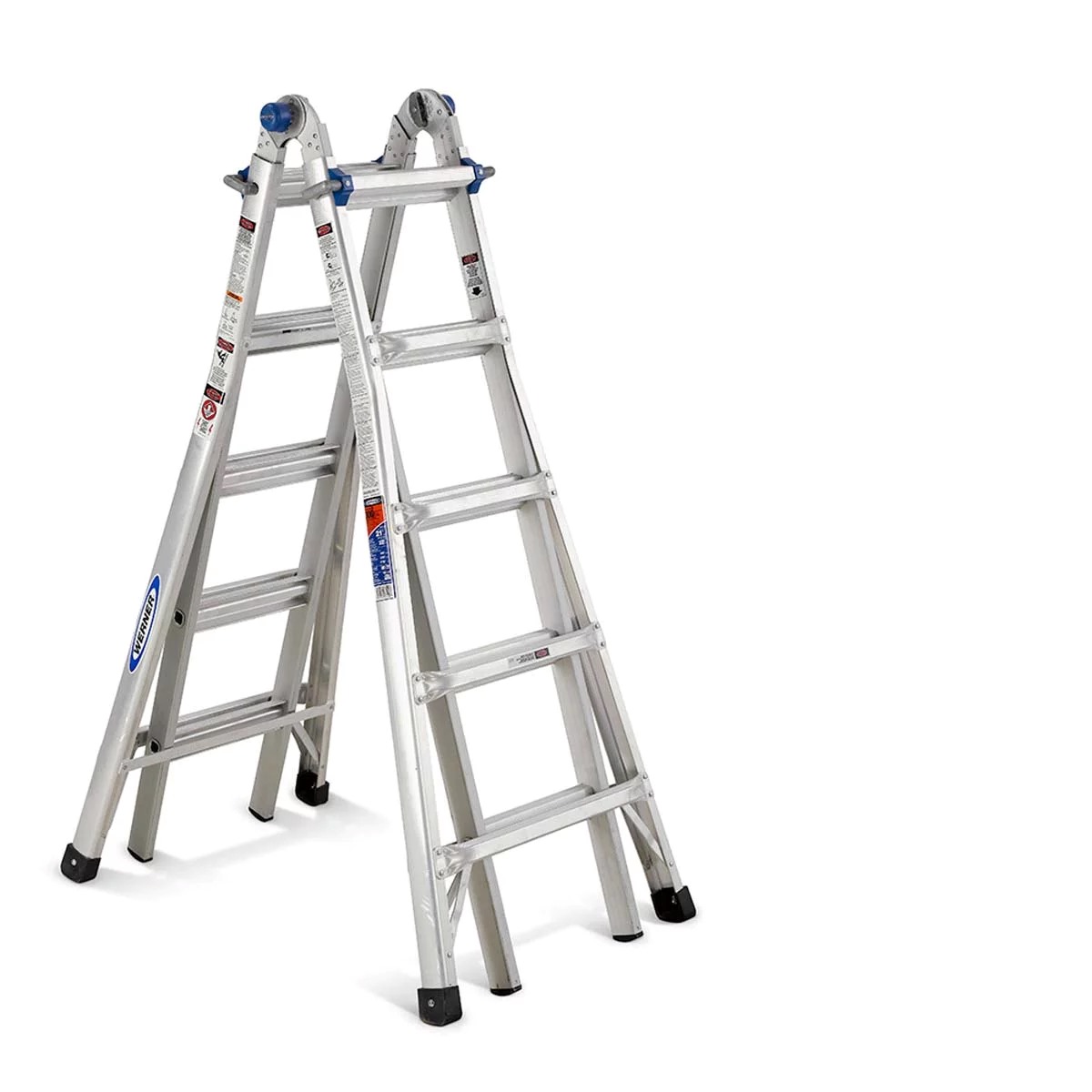

Articles
What Is The Working Length Of A Ladder
Modified: August 21, 2024
Read this article to understand the working length of a ladder. Discover the key factors that determine ladder height and how to measure it accurately.
(Many of the links in this article redirect to a specific reviewed product. Your purchase of these products through affiliate links helps to generate commission for Storables.com, at no extra cost. Learn more)
Introduction
When it comes to using ladders for any task, determining the correct working length is crucial for ensuring safety and efficiency. A ladder that is too short may not reach the desired height, while a ladder that is too long risks instability and potential accidents. In this article, we will explore what exactly is meant by the working length of a ladder and its significance in various applications.
Definition of Working Length
The working length of a ladder refers to the usable portion of the ladder that extends from the base to the highest safe standing level. It is the distance between the ground or floor and the topmost rung or step that can be safely accessed by the user. It is important to note that the working length does not include any portion of the ladder that extends beyond the highest safe standing level, such as the top rung or the ladder’s extension.
Factors Affecting Working Length
Several factors come into play when determining the appropriate working length for a ladder. These include:
- Task Requirements: The nature of the task being performed will determine the height at which the user needs to access. Whether it is reaching a light fixture, painting a wall, or accessing a roof, the required working length will vary accordingly.
- Ladder Type: Different types of ladders, such as step ladders, extension ladders, and platform ladders, have varying working lengths due to their design and construction. It is essential to select the ladder type that best suits the task at hand.
- User Height: The height of the user is an important factor when determining the working length. A taller person may require a longer ladder to comfortably reach the desired height.
- Ground Surface: The stability of the ground or floor surface where the ladder will be positioned affects the working length. Uneven ground or slippery surfaces may necessitate a shorter working length to maintain ladder stability.
Key Takeaways:
- Determining the correct working length of a ladder is crucial for safety, stability, and efficiency. Factors such as task requirements, ladder type, user height, and ground surface play a significant role in ensuring the ladder is set up at the optimal height.
- Accurately measuring the working length of a ladder is essential for safe and effective usage. Avoid common mistakes such as estimating instead of measuring, ignoring user height, and setting up the ladder at an incorrect angle. Prioritize safety, follow proper guidelines, and promote a culture of safety in all ladder-related activities.
Definition of Working Length
The working length of a ladder refers to the usable portion of the ladder that extends from the base to the highest safe standing level. It is essentially the distance between the ground or floor and the topmost rung or step that can be safely accessed by the user.
When determining the working length, it is important to consider the ladder’s maximum reach, which includes the length of the ladder itself and any extension features it may have. However, it is crucial to note that the working length does not include any portion of the ladder that extends beyond the highest safe standing level, such as the top rung or the ladder’s extension.
The working length is a fundamental measurement that ensures the ladder is set up at the correct height to safely perform the intended task. It is essential for the user to be able to reach the desired height without overextending or creating unstable conditions.
The height at which the working length is set can vary depending on the specific task requirements. Whether it is painting a wall, cleaning gutters, or accessing a roof, the working length must be carefully determined to provide the optimal height and stability for the user.
Additionally, it is important to mention that the working length can differ between different types of ladders. For instance, step ladders have a fixed working length, while extension ladders have an adjustable working length due to their ability to extend and retract.
Ultimately, properly understanding and measuring the working length of a ladder is imperative for maintaining safety and preventing accidents. It ensures that the ladder is appropriate for the intended task and that users can work at heights with confidence and stability.
Factors Affecting Working Length
Several factors come into play when determining the appropriate working length for a ladder. Understanding these factors is crucial to ensure that the ladder is set up at the correct height for safe and efficient use. Here are some key factors that affect the working length:
- Task Requirements: The nature of the task being performed is one of the primary factors to consider when determining the working length of a ladder. Different tasks require users to reach different heights. For example, changing a light bulb might only require a short working length, while reaching a high ceiling or working on a roof might require a longer working length.
- Ladder Type: Different types of ladders have varying working lengths due to their design and construction. Step ladders typically have a fixed working length since they cannot be extended or retracted. Extension ladders, on the other hand, offer adjustable working lengths. These ladders consist of two or more sections that can be extended or retracted to reach varying heights.
- User Height: The height of the user is an important consideration when determining the working length. A person who is taller may require a longer working length to comfortably reach the desired height. It’s important to choose a ladder that accommodates the height of the user for maximum safety and comfort.
- Ground Surface: The stability of the ground or floor surface where the ladder will be positioned can affect the working length. Uneven or soft ground may cause the ladder to tilt or sink, requiring a shorter working length to maintain stability. It’s crucial to ensure that the ladder is set up on a level and firm surface.
- Ladder Angle: The angle at which the ladder is set up plays a role in determining the working length. The ladder should be positioned at the correct angle to ensure stability and prevent slipping or falling. The recommended angle is typically around 75 degrees, which allows for optimal balance and stability.
By considering these factors, users can determine the appropriate working length for their specific needs. It is essential to select a ladder that provides the necessary working length to safely and effectively complete the task at hand.
Importance of Determining the Correct Working Length
Determining the correct working length of a ladder is of utmost importance for several reasons. It ensures the safety of the user, maximizes efficiency in completing tasks, and helps prevent accidents or injuries. Let’s delve into the significance of determining the correct working length:
- Safety: One of the primary reasons for determining the correct working length is to ensure the safety of the user. Using a ladder that is too short may require overreaching, leading to loss of balance and potential falls. On the other hand, a ladder that is too long can become unstable, increasing the risk of accidents. By setting the ladder at the correct working length, users can work at a comfortable height without compromising their safety.
- Stability: Determining the correct working length also enhances the stability of the ladder. When the ladder is set at an appropriate height, it reduces the risk of it wobbling or tipping over during use. A stable ladder provides a secure platform for users to perform tasks confidently and reduces the chances of accidents caused by ladder instability.
- Efficiency: Setting the ladder at the correct working length ensures optimal efficiency in completing tasks. It allows users to work comfortably at the desired height, eliminating the need for constant adjustments or overextending. This efficiency not only saves time but also minimizes the chances of fatigue or muscle strain that can result from working in awkward or uncomfortable positions.
- Preventing Damage: Using a ladder with the correct working length helps prevent damage to the surrounding environment, objects, or structures. A ladder set too short may cause users to lean or apply excessive pressure on surfaces, leading to scratches, dents, or even breakage. Conversely, a ladder that is too long may risk accidental contact with ceilings or obstacles, potentially causing damage or injury.
- Compliance: Many industries have specific regulations and standards in place regarding ladder safety. These regulations often include guidelines on determining the correct working length of ladders to ensure compliance with safety standards. Adhering to these regulations not only promotes a safe working environment but also avoids potential legal liabilities or penalties.
By determining the correct working length of a ladder, users prioritize safety, stability, efficiency, and compliance. It allows for productive and secure completion of various tasks, regardless of the industry or application. Whether you are a homeowner performing DIY projects or a professional contractor, taking the time to determine the correct working length is a vital step in ladder safety and overall job success.
When using a ladder, always make sure to measure the working length properly. The working length is the actual length of the ladder when it is set up and in use, and it should be at least 3 feet higher than the point of support.
Methods for Measuring Working Length
Accurately measuring the working length of a ladder is crucial for ensuring safety and effectiveness in its usage. Here are some common methods for measuring the working length:
- Tape Measure: Using a tape measure is a straightforward method to measure the working length of a ladder. Place the base of the ladder on a flat surface and extend it to its maximum height. Stand at the ladder’s base and measure from the ground to the highest safe standing level. This measurement will give you the working length of the ladder.
- Reference Point: Another method is to determine a reference point on the ladder to identify the working length. For example, on an extension ladder, mark the highest safe standing level. Once the ladder is fully extended, ensure that the marking aligns with the desired height. This method allows for quick and easy identification of the working length during ladder setup.
- Manufacturer’s Guidelines: Many ladder manufacturers provide guidelines or instructions on how to determine the working length of their specific ladder models. It is recommended to refer to these guidelines as they may include specific measurements or indicators designed for accurate determination of the working length.
- Visual Reference: In some cases, visual cues may be used to determine the working length. For example, step ladders often have built-in indicators, such as color-coded steps or lines on the side rails, which indicate the highest safe standing level. Users can visually align the ladder with their desired height based on these indicators.
- Professional Assistance: When in doubt or for more complex ladder systems, consulting with a professional or ladder expert can be beneficial. They can provide guidance on how to properly measure the working length for specific ladder types and applications.
Regardless of the method used, it is essential to follow proper safety practices when measuring the working length. Ensure that the ladder is on a stable surface, take accurate measurements, and double-check against manufacturer guidelines or regulations to ensure compliance and safety.
Remember, accurately measuring the working length of a ladder is a critical step in setting it up at the correct height for safe and efficient use. By utilizing these methods, users can confidently determine the working length and work with peace of mind.
Common Mistakes in Determining Working Length
Determining the correct working length of a ladder is crucial for safety and efficiency. However, there are some common mistakes that people often make when determining the working length. Being aware of these mistakes can help you avoid potential hazards and ensure proper ladder usage. Here are some of the most common mistakes to watch out for:
- Estimating Instead of Measuring: One of the most prevalent mistakes is relying on estimation rather than actual measurement. Guessing or approximating the working length can lead to inadequate ladder setup, which compromises safety. Always use a tape measure or follow manufacturer guidelines to obtain accurate measurements.
- Ignoring User Height: Neglecting to consider the height of the user can result in selecting a ladder that is too short or too tall. If the ladder is not suitable for the user’s height, it can create uncomfortable working conditions and increase the risk of accidents. Take into account the user’s height to ensure the ladder provides sufficient working length.
- Incorrect Angle of the Ladder: Another common mistake is setting up the ladder at an incorrect angle. The recommended ladder angle is around 75 degrees, providing optimal stability and weight distribution. A ladder that is too vertical or too slanted can affect the working length and compromise safety during use.
- Not Considering Task Requirements: Failing to consider the specific task requirements can result in selecting the wrong working length. Different tasks require different working heights, and using a ladder that does not reach the necessary height can lead to unnecessary strain or unsafe practices. Evaluate the task at hand and choose a ladder with the appropriate working length.
- Overreaching: Overreaching is a significant mistake that often occurs when the ladder’s working length is too short. To compensate, users tend to lean or stretch beyond their reach, introducing a higher risk of falls or injuries. It is crucial to ensure the ladder’s working length allows users to access the desired height without overreaching.
- Ignoring Safety Guidelines: Neglecting to follow safety guidelines and regulations is a critical mistake in determining the working length. Safety standards exist for a reason and ensure proper ladder usage and user protection. Familiarize yourself with safety guidelines and adhere to them throughout the process of measuring and setting the working length.
Avoiding these common mistakes will help ensure that you select the appropriate working length for your ladder and promote a safe working environment. Take the time to accurately measure, consider user height, follow safety guidelines, and assess task requirements. By doing so, you will enhance safety, efficiency, and overall ladder performance.
Safety Considerations for Using Ladders at the Working Length
Using ladders at the correct working length is essential for safety. However, there are several additional safety considerations to keep in mind when working with ladders. These precautions help minimize risks and ensure a safe working environment. Here are some important safety considerations when using ladders at the working length:
- Ladder Inspection: Before using a ladder, it is crucial to inspect it thoroughly. Check for any damaged or worn-out components, such as rungs, steps, rails, or hardware. Ensure that all parts are in proper working condition, and if any issues are found, do not use the ladder until it is repaired or replaced.
- Stable Placement: Place the ladder on a stable and level surface. Avoid slippery or uneven ground, as it can compromise ladder stability. Consider using ladder stabilizers or leveling devices for added stability, especially on uneven surfaces.
- Proper Angle: Set up the ladder at the correct angle. As a general rule, the ladder’s base should be placed one foot away from the vertical support for every four feet of ladder height. This provides proper stability and prevents the ladder from tipping over.
- Three-Point Contact: Maintain three-point contact when climbing the ladder. This means having two hands and one foot or two feet and one hand on the ladder at all times. Avoid carrying heavy objects or tools while climbing, as it can affect balance and stability.
- No Overreaching: Do not overreach when working on a ladder. Your belt buckle should remain within the ladder’s side rails to maintain stability. Overreaching can cause the ladder to shift, increasing the risk of falling or losing balance.
- Use the Right Type of Ladder: Select the appropriate ladder for the task at hand. Different tasks require different ladder types, such as step ladders, extension ladders, or platform ladders. Using the right ladder ensures proper stability and working height.
- Secure Climbing: Ascend and descend the ladder with caution. Hold onto the ladder with both hands and face the ladder while climbing up or down. Avoid sudden movements or distractions that can compromise your balance.
- Work Zone Safety: Ensure the work area is clear of any tripping hazards or obstructions. Maintain a safe distance from power lines or overhead obstacles. Use caution when working near doors, windows, or heavy machinery that could potentially collide with or disturb the ladder.
- Good Housekeeping: Keep the work area clean and tidy. Avoid leaving tools, debris, or materials on the ladder steps or in its vicinity, as they can cause slips or falls.
- Training and Education: Provide proper training and education to ladder users on ladder safety, including how to set up and use ladders correctly. Regularly review safety guidelines and encourage a safety-conscious attitude when working at heights.
By adhering to these safety considerations, you can significantly reduce the likelihood of accidents and injuries while using ladders at the working length. Prioritize safety, take precautionary measures, and continuously promote a culture of safety in all ladder-related activities.
Conclusion
The working length of a ladder is a critical factor in ensuring safety, efficiency, and successful completion of tasks at various heights. By accurately determining the working length, users can work confidently and securely without compromising their well-being.
In this article, we explored the definition of the working length, the factors that affect it, and the importance of determining the correct working length for different applications. We discussed common methods for measuring the working length and highlighted potential mistakes to avoid when determining it. Additionally, we emphasized the safety considerations that should be taken into account when using ladders at the working length.
Setting up a ladder at the correct working length can prevent accidents, enhance stability, and improve efficiency in completing tasks. It is important to consider various aspects such as the task requirements, ladder type, user height, ground surface, and ladder angle. By following proper safety guidelines, conducting regular ladder inspections, and ensuring stable placement, users can minimize risks and create a safe working environment.
Remember, ladder safety is a collective effort that requires knowledge, attention, and adherence to best practices. Regular training, education, and ongoing awareness are vital components in promoting a culture of safety when working with ladders.
In conclusion, understanding and determining the correct working length of a ladder should be a priority for anyone working at heights. By doing so, users can maximize safety, increase efficiency, and successfully complete tasks with confidence.
Frequently Asked Questions about What Is The Working Length Of A Ladder
Was this page helpful?
At Storables.com, we guarantee accurate and reliable information. Our content, validated by Expert Board Contributors, is crafted following stringent Editorial Policies. We're committed to providing you with well-researched, expert-backed insights for all your informational needs.















0 thoughts on “What Is The Working Length Of A Ladder”